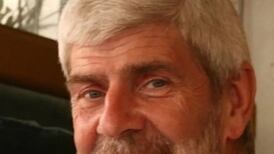Handball has been played in Ireland for centuries. In 1527 the statutes of Galway forbade the playing of handball against the walls of the town.
More recently it has been part of the GAA's family of sports, along with hurling, football, camogie and rounders. Almost every town and village had its handball alley, a stark, functional structure dominating the skyline. And Ireland still celebrates its handball heroes, the most renowned being Kilkenny's Michael "Ducksie" Walsh, Ireland's most honoured player, who has died aged 50.
Walsh did not know why he was called Ducksie. “A lot of Walshs in Kilkenny are called Ducksie. When I got married even the priest called me Ducksie,” he told historian Turtle Bunbury in an interview for the Vanishing Ireland project.
And what a champion. By the the age of 44, he had won 38 All-Ireland titles in 16 years. This was possible because handball is played on two court sizes, 60ft x 30ft and 40ft x 20ft. Both sizes have all-Ireland titles. Walsh won 23 singles and 15 doubles titles. Celebrated Kilkenny hurler DJ Carey partnered him in three doubles victories.
Why was Kilkenny such a hotbed of handball as well as hurling? Some credit for that must go to Ellen, Lady Desart, a London-born philanthropist who lived in Co Kilkenny with her Anglo-Irish husband William Cuffe, the fourth earl of Desart. She provided covered handball alleys for the model village she endowed at Talbot’s Inch at Kilkenny, opened in 1928.
Magic touch
In childhood, Ducksie’s cousin Billy Burke, who would also later be an All-Ireland champion, introduced him to handball. Aged nine, Walsh began playing at the municipal courts near St Canice’s Church in Kilkenny. Soon he was winning small sums of money.
Talbot’s Inch handball club was a forcing ground for champions. Celebrated coach Tommy O’Brien heard of the left-handed boy with the magic touch. At the age of 10, Walsh won his first All-Ireland (under-12) medal.
In 1981, O’Brien selected the 14-year-old for the first Irish team to participate in the US national junior championships. The secret was practising for two to three hours, six days a week. “I always trained fierce hard,” he told Bunbury.
Walsh’s father Seán worked as a security guard. He and his wife Vera raised their eight children in the area of Kilkenny city known as the Butts. On leaving school, Michael Walsh was apprenticed to a cabinet-maker, and later made a living fitting kitchens and bathrooms.
Success on the handball court came at a price. The heavy drinking that almost inevitably followed successive victories resulted in the realisation in 2001 that he was an alcoholic. The discipline that had sustained his sporting success had not totally deserted him. He checked into a treatment centre and “dried out”, and stayed that way.
Comeback
Almost as remarkable was his return to first-class handball at a time when many had written him off. Barely two weeks before he died, Walsh defeated number one-ranked Eoin Kennedy of Dublin in the final of the open singles in the inaugural Irish 60x30 Singles Nationals at his home court of Talbot’s Inch.
He became unwell on his way from a handball tournament in Cavan, and died a few days later in Beaumont hospital, Dublin.
Walsh is survived by his widow Sheena, son Dylan, daughters Megan and Niamh, brothers John, Billy and Jimmy, and sisters Vera and Regina.










